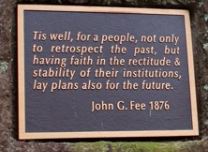
The War of 1812 was a necessary corrective to British arrogance, or an unnecessary catastrophe, or a tragic blunder, or a hairsbreadth escape, or an expensive stalemate, or an amazing victory, or the basis for continued independence and lasting peace, depending on who you listen to and how you see it. Maybe it was all of these things. As with nearly all wars, the country that emerged was quite different from the one that had entered the war.
Great Britain’s provocative and often outrageous policies had been stoking American anger for years. British warships stopped American ships outside American harbors and impressed into their own navy any sailors who in their opinion were British deserters. They seized any cargo that in their opinion was contraband. In 1807, a British warship had even fired on an American warship in American waters. Years of such incidents had their effect. Jefferson’s response, as we shall see, had been the Embargo, but that policy had lapsed with his presidency, on March 4, 1809.
In 1810, the West and South elected to Congress a group of young Republicans who boiled with resentment of the economic injuries done by the British, and the national humiliation inflicted, and the British practice of inciting American Indians in the Northwest against white settlers., They intended to seize Canada and either annex it or hold it as a bargaining chip, and thought it would be easy. When, in June, 1812, President James Madison asked Congress to declare war, these War Hawks provided his margin. (Not one of the 39 Federalists in Congress voted for war.)
The war was fought on the Canadian border and the Great Lakes, on the seas, and in the Southwest.
In the North, an American invasion of Canada failed, but American naval victories on Lake Erie and Lake Champlain prevented a corresponding British invasion of the United States. More important results followed the Battle of the Thames, in 1813, when General William Henry Harrison’s forces defeated a smaller British force and killed the Shawnee chief Tecumseh.
Tecumseh had preached unity among all these Northwestern and Southwestern tribes, advocating a concerted effort to throw back the white settlers. Although he fought north of the Ohio, he encouraged the Red Stick Creek Indians to attack white settlements in northern Alabama and Georgia, and the Fort Mims massacre, which killed 400 to 500 settlers, set off what was known as the Creek War. That war ended in March, 1814, when Andrew Jackson’s mixed force of army regulars, Tennessee militiaman, and Cherokee, Choctaw and Creek Indians decisively defeated the Red Sticks in the Battle of Horseshoe Bend. This action made Jackson a Major General and, along with his victory at New Orleans ten months later, a national hero.
At sea, the British strategy was to protect its own merchant shipping and blockade major American ports (except New England, which traded with Canada in defiance of American laws). American strategy was to employ hit-and-run tactics and engage Royal Navy vessels only under favorable circumstances. After the defeat of Napoleon freed military forces for use in the New World, the British mounted large-scale raids along the seacoasts, and three invasions. One failed to invade New York state via Lake Champlain, the second took Washington, D.C. and burned the Capitol and the White House but was repulsed at Baltimore, and the third was decimated at New Orleans.
Each side used both warships and privateers to attack the other’s merchant ships. (This was the last war in which the British used privateers) . American privateers captured 219 British merchant ships in the first four months of war, damaging British commercial interests, but not enough to send insurance rates soaring, which was their hope.
As additional ships were sent to North America in 1813, the Royal Navy tightened its blockade and extended it, by May 31, 1814, to the entire American coast. American exports decreased from $130 million in prewar 1807 to $7 million in 1814 – and most of the $7 million was in food exports that went to Britain or British colonies.
However, by mid-1814, neither the Americans nor the British wanted to continue the war. After a few months of haggling, they signed the Treaty of Ghent (in Belgium) on December 24, 1814, officially ending the war by returning relations to their pre-war status, with no territory lost or gained, and impressment left unmentioned because moot. The treaty was ratified by the British on December 27, and was quickly ratified after it arrived in Washington on February 17, 1815.
Meanwhile, on January 8, with neither side knowing that the peace had been signed, 8,000 British regulars trying to capture New Orleans were decisively defeated by Andrew Jackson’s 5,000-man army, which had prepared strong defenses just south of the city. The British regulars suffered heavy losses, amounting to more than 25% of their forces — 291 dead, 1,262 wounded, and 484 captured or missing. American casualties were less than two percent of their forces — 13 dead, 39 wounded, and 19 missing. The lopsided victory earned Jackson the official Thanks of Congress, and a gold medal. Meanwhile, the British had taken Mobile, but then, the following day, learned of the Treaty of Ghent, and so sailed home.
The big losers in the war were the Indians allied to the British. The British had demanded, as late as the fall of 1814, that a large “neutral” Indian state be created in what would become Ohio, Indiana, and Michigan, but the Americans absolutely refused, and the British conceded the point. After 1814, British policymakers never again offered the Indians arms or encouragement, and without that powerful foreign sponsor, the Indians posed no further threat to white settlement.
Other than the Indians, the big losers from the war were the New England federalists, who had flirted with treason throughout the war and had met, in Hartford Connecticut, late in 1814 to discuss resistance to the war and even possible secession from the rest of the Union. But the end of the war made their publicly expressed views look defeatist or even treasonous. The Hartford Convention spelled the end of the Federalist Party.
Abstractly considered, it could be considered an unnecessary war. But in practice, while the British were what they were and the Americans were what they were, and the Indians what they were, there was little or no chance that the war could have been avoided. The best chance for that had been Thomas Jefferson’s experiment at economic coercion in place of war, as we shall see. But statesmen are rarely as reasonable as he.
